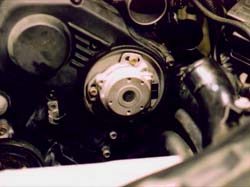|
TimingTweak: There has beena lot of discussion and interest in adjusting the timing of the TT to gainhorsepower (I have not done this on a NA, but it could be done). First off, a disclaimer, Jim Wolf does not recommend adjusting the timing,if anything, he suggests setting it at 13 degrees (stock TT is 15 degrees+ or - 2 degrees). However, there are other opinions out there aboutthe safety and potential for horsepower. So, it is up to each individualto decide if this something they want to do. My suggestionis to do some research on your own. NOTE: We'vesince found the '96 NAs are factory @ 10 degrees BTC, so make adjustmentsaccordingly. Tools: Realize the specific timing set from the factory varies from car to car. Case in point:
Make an initial run on the Dyno Jet for a baseline and check yourboost level (don't want to be running too much - 15lbs max. for Stage IIIor too little). Check the stock timing with a timinglight. If you don't have access to a timing light, you can stilldo this, but it is not as safe. If you don't have access to a DynoJet, then just proceed to the next step. To adjust the timing youare going to loosen the three 10 mm bolts on the crank angle sensor. This sensor is located on the front right of the engine (when facing theengine from the front of the car), behind the fan. It is about 3"in diameter, silver, and has a black connector attached to the right side.
 Before looseningthe bolts you need to scratch a mark into the metal of the crank anglesensor & engine, so you will know where the stock setting was. OK, you have loosened (NOT REMOVED) the three bolts. Now, using theplastic handle of a screw driver (or other such device) you are going toTAP on the left side of the crank angle sensor (Counter Clockwise) untilyou have moved the mark you previously made by a millimeter (mm), that'sright, one millimeter. Make very small adjustments, then tightenthe bolts back up some so that the crank angle sensor does not move. Make another Dyno Jet run and compare the results. Check the timingagain with the timing light. The non-technicalway to proceed is to keep upping the timing by very small increments andrerunning on the Dyno Jet until you encounter safety boost (i.e. detonation). If you don't have access to a Dyno Jet, find access. If you stillcan't then you are really going to have go out and make some runs on thestreet. I DO NOT RECOMMEND THIS. You need some type of controlledenvironment! Detonation can be heard & stopped on the Dynojetbefore damage can occur. At this point, back the timing off some(tapping clockwise). Make another mark on the metal, this is yourhighest timing limit. I am personally running in between the stocksetting and the highest setting that I could safely run. The technicalway to proceed is to just use the timing light to set the timing. I would not recommend going higher than 17 - 19 degrees. Make someruns on the Dyno Jet at various settings to document the changes. That's it. Make sure you tighten everything up. If you live in a hot and/orhumid area, you may encounter safety boost problems, if you made the markson the crank angle sensor, you can always move it back to stock for a whileuntil it gets cooler. Submitted by xxx@******.com Revision 0 Article submitted on 1 May 2010 Viewed 12645 times |
|
|
||||